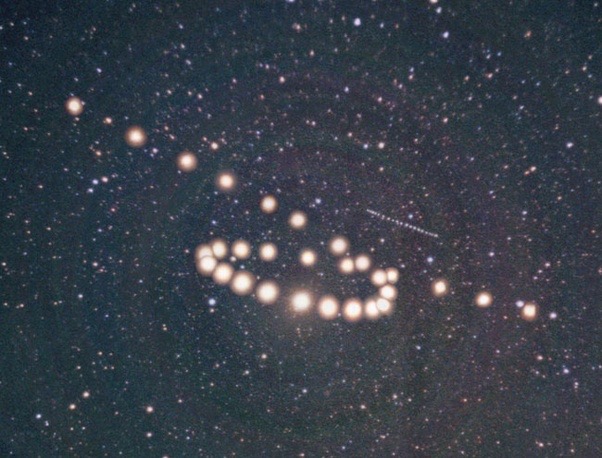Mars, Jupiter and Saturn, and also Uranus and Neptune, are the superior planets, that is, the planets further from the Sun than the Earth. Venus and Mercury are the inferior planets, closer to the Sun than the Earth. This Page is mainly about Mars.
Mars, Jupiter and Saturn are very easy to see in the Night Sky but Neptune cannot be seen without a telescope. Uranus is just visible to the naked eye, with a magnitude of between 5.4 and 6.0 depending upon its distance from the Earth, but it moves so slowly against the background of the fixed stars that it was not identified as a planet (that is, a moving star) until 1781, by Sir William Herschel (1738 - 1822). Fixed and moving stars are more fully explained on an earlier Page.
Even with the naked eye Mars can be seen as red, so it is often often referred to as the Red Planet, although in early science fiction Martians were usually portrayed as Little Green Men. Seen from anywhere in the Solar System other than its surface the Earth is a most beautiful blue colour, hence the tv series The Blue Planet. (We call our planet Earth because that is the part of it on which we live but Martians would call it Ocean because that is what most of it is.) In all the pictures following the Sun is shown as yellow, the Earth as blue and Mars as red.
The Earth is about 150 million kilometres from the Sun and goes round it in about 365 days whereas Mars is about 230 million kilometres from the Sun and goes round it in about 690 days.
As the Earth and Mars go round the Sun at different rates sometimes they are all in a straight line. This is called a conjunction. If the Earth is at the end of the line Mars is at superior conjunction and if it is in the middle Mars is at inferior conjunction. So at superior conjunction they are as far as possible from each other and at inferior conjenction they are as close as possible.
If the Earth goes round the Sun in 365 days and Mars in 690 days, in the time it takes the Earth to move 30 degrees Mars will only have moved about 16 degrees. If we measure the position of Mars against the fixed stars once a month to an accuracy of one degree these pictures following show how Mars seems to move among them.
The way Mars and the other planets and the Sun and Moon move against the background of the fixed stars is more fully described on the Page on the Ecliptic and the Zodiac.
We start our observations at a time when Mars is at superior conjunction: this time (but not of course every time) it is the beginning of February so both the Sun and Mars are in Aquarius.

Mars reaches inferior conjunction in about fourteen months, and superior conjunction about every twenty eight months.
We cannot of course see Mars at superior conjunction as it is in a line with the Sun and rises and sets at the same time as the Sun. A few days later it will rise just before Sunrise and so we shall see it as a morning star, then at inferior conjunction it will rise at sunset and set at sunrise so we shall see it all night, then it becomes an evening star visible just after sunset.
We can see that after superior conjunction the Sun and Mars move through the constellations in order, from Aquarius to Pisces to Aries etc. We can see from this animation that the Sun moves through the constellations in a year and in a totally regular way, but something odd happens to Mars at the time of inferior conjunction.
If we measure the position of Mars every night and measure its position much more accurately we can see that for a few days at the time of inferior conjunction, when the Earth is overtaking Mars, Mars changes the direction in which it is moving against the background of the fixed stars - this is called retrograde motion. Mars is at its nearest to the Earth, and so at its brightest, at this time.

This time of retrograde motion is enormously important when we try to understand what happened at the beginnng of the 17th Century and the time of the The Great Change, when people were beginning to believe that the Earth went round the Sun rather than the Sun going round the Earth. The other planets behave in a similar way, but Mars is easiest to observe because Mercury and Venus are only visible just after Sunset or just before Sunrise, and Jupiter and Saturn are much further from the Sun and so move against the background of the Fixed Stars much more slowly. (Uranus moves so slowly against the background of the fixed stars that it was not realised it was a planet until 1781!)
©Barry Gray September 2023